n
Between 2006 and 2010 I had the privilege and great pleasure of helping with the Master’s Exam in London four times. Over the years, the U.K. exam has been a smaller event with anywhere from 14 to 25 students compared to the 60-70 candidates that regularly take the exam in the U.S. In London the exam is given over two days at couple of the city’s finest hotels; the Capital and the world-famous Dorchester. The theory exam is given on day one at the Capital’ the tasting and service exams are conducted at the Dorchester on day two with a reception and dinner following at the hotel. Dinner on the first night is traditionally held at Motcombs.
This was my fourth dinner at Motcombs and the only difference was the conspicuous absence of the legendary Val Brown. Percival Brown has been a mainstay of the London wine and spirits trade for the last 70+ years. His career began in the mid 1940’s and he is without doubt among the who’s who of the London trade. Val’s energy is boundless and his jokes pointed and endless. Val’s presence also means several mystery bottles of Bordeaux to be blind tasted during the meal. Mind you, this is not the usual affair with bottles wrapped in cloth bags or foil. The solution is far simpler due to a tragic occurrence. The bottles Val brings to the annual Motcombs’ dinners are victims of a flood in one of his cellars; a flood that deprived all the bottles of their labels. Practically all the wine in this particular cellar was Bordeaux from the ‘50’s and ‘60’s. It’s then up to us, members of the examining team, to divine the vintage, commune—and if possible—the chateaux behind these mystery bottles. Having little personal experience with tasting claret from the ‘60’s, I have to say that the wines are striking but not for the reasons one would imagine.
In style, the wines from Val’s cellar are about as far away from today’s Bordeaux as the Dog Star. Without exception, they show the depth of color somewhere between aged Reserva Rioja and Grand Cru Burgundy. Bottles I tasted in the past such as 1963 Gruaud-Larose, 1966 Lynch-Bages, and 1960 Léoville-Barton were medium-bodied wines at best; elegant, refined, autumnal, and very complex. For the record, I never had luck identifying much of anything. However, fellow U.K. Master’s Brian Julyan and Brian Dawes were usually spot on with vintages and communes—sometimes Chateaux—having grown up with the wines during the early part of their careers.
But on this night Val couldn’t make dinner as he had a previous engagement with one of his kids that couldn’t be broken. So we raised a glass in his honor and then set about to examining the menu for dinner. Past meals at the restaurant provided me an opportunity to try several different game birds but tonight the only game listed on the menu was the gamiest of them all—grouse. I had grouse on my first visit to the restaurant and remember it as clearly as my first Fernet Branca—and for good reason. The two have a lot in common; they’re completely bitter in taste. I’m not sure why this little feathery beast has such a strong liver flavor but it does so in spades. Perhaps it’s like other denizens of the animal kingdom that upon the rush of unexpected and usually dramatic death release various chemical substances into their blood stream as a final defiant “screw you” gesture to the universe at large. But I don’t think that’s true here. Fellow MS Nigel Wilkinson informed us fact that most grouse in the UK is domestically raised now and released just before the fall season. If true, then surely these poor little mutant birds, roughly half the size of a not-so-free-range chicken, are fattened up briefly before being released into the “wild” only to be blown not-quite-to-bits by some great hunter.
Whatever the case, I was not about to pass up the opportunity to partake and I did so and done medium, thank you. After appetizers and Champagne were enjoyed, my roasted friend appeared on a massive oval plate perched atop a large piece of toast. The waiter offered sides to accompany the festively bitter fowl including a rich gravy, some kind of wobbly white gelatinous substance (suet), and fine roasted breadcrumbs. I opted just for the gravy. A large slab of bacon was draped over the top of the bird offering a salt and fat counterpoint to the gamey, impending bitterness. I tucked in and relished one of the great epicurean traditions of the fall season, hunting, and the sacrifice of all things small and plucked. And it was good.
Cheers!
nn
